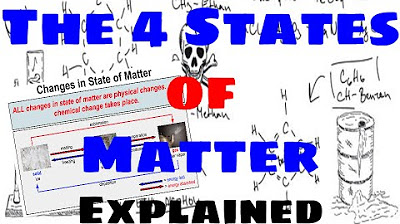What Is Plasma | Properties of Matter | Chemistry | FuseSchool
Summary
TLDRThis lesson introduces plasma, the fourth state of matter, distinct from solid, liquid, and gas. It explains how substances transition from gas to plasma under extreme heat, where electrons are stripped from atoms, forming free electrons and positive ions. Plasma's unique ability to conduct electricity, unlike gases, is highlighted, with examples from natural phenomena like lightning and the northern lights, to man-made applications in fluorescent light bulbs and plasma screen TVs. The lesson also touches on how plasma's high-definition capabilities enhance visual displays.
Takeaways
- 🧊 The script introduces a fourth state of matter, plasma, beyond the commonly known solid, liquid, and gas states.
- 🔥 When ice is heated sufficiently, it melts into water, transitioning from a solid to a liquid state.
- 🔬 In a solid, particles are closely packed and fixed in position, giving the substance a definite shape and volume.
- 💧 In a liquid, particles are still in contact but can move past each other, maintaining a fixed volume but taking the shape of the container.
- 🌡 Heating water to 100 degrees Celsius causes it to evaporate into a gas, specifically water vapor.
- 🌫 In a gas, particles are far apart, filling the shape and volume of their container.
- 🔥🌌 To create plasma from a gas, extremely high temperatures are required to strip electrons from atoms, forming free electrons and positive ions.
- ⚡ Plasma is electrically conductive due to the presence of free electrons, distinguishing it from a non-conductive gas.
- 🌌🌩 Naturally occurring plasmas include phenomena like lightning, the Northern Lights, and stars, which are essentially hot balls of plasma.
- 💡 Plasma technology is used in fluorescent light bulbs and neon signs, where an electric current heats mercury vapor to create plasma.
- 📺 Plasma TVs utilize thousands of tiny pixels, each with three fluorescent light electrodes emitting red, green, and blue light, to display a wide range of colors.
Q & A
What are the three traditional states of matter?
-The three traditional states of matter are solid, liquid, and gas.
What is the fourth state of matter discussed in the script?
-The fourth state of matter discussed in the script is plasma.
What happens when ice is sufficiently heated?
-When ice is sufficiently heated, it melts to form water, undergoing a change of state from solid to liquid.
What are the characteristics of particles in a solid?
-In a solid, particles are closely packed in a fixed position, giving the substance a fixed shape and volume.
How do the particles in a liquid differ from those in a solid?
-In a liquid, particles are still touching one another but can move around each other, resulting in a fixed volume but the ability to take the shape of their container.
What is the change of state that occurs when water is heated to 100 degrees Celsius?
-When water is heated to 100 degrees Celsius, it evaporates from a liquid to a gas, specifically water vapor.
How do particles in a gas differ from those in a liquid?
-In a gas, particles are further away from one another and take the shape and volume of their container, unlike in a liquid where they are still in contact.
What is required for a substance to change from a gas to plasma?
-For a substance to change from a gas to plasma, very strong heat must be applied to strip electrons from their respective atoms, creating free electrons and positive ions.
Why is plasma considered electrically conductive?
-Plasma is considered electrically conductive because it contains free electrons, which allow it to conduct electricity, unlike regular gases.
What are some naturally occurring examples of plasma?
-Naturally occurring examples of plasma include lightning, the Northern Lights, and stars, which are hot balls of plasma.
How is plasma utilized in fluorescent light bulbs and plasma screen TVs?
-In fluorescent light bulbs, an electrical current passed through mercury vapor heats the gas enough to create plasma. Plasma screen TVs are made possible by the use of many tiny dots called pixels, each made of three fluorescent light electrodes emitting red, green, and blue light, which combine to produce any color.
How does the number of pixels in a plasma screen affect the image quality?
-The higher the number of pixels in a plasma screen, the higher the definition, resulting in sharper and more detailed images.
Outlines

Этот раздел доступен только подписчикам платных тарифов. Пожалуйста, перейдите на платный тариф для доступа.
Перейти на платный тарифMindmap

Этот раздел доступен только подписчикам платных тарифов. Пожалуйста, перейдите на платный тариф для доступа.
Перейти на платный тарифKeywords

Этот раздел доступен только подписчикам платных тарифов. Пожалуйста, перейдите на платный тариф для доступа.
Перейти на платный тарифHighlights

Этот раздел доступен только подписчикам платных тарифов. Пожалуйста, перейдите на платный тариф для доступа.
Перейти на платный тарифTranscripts

Этот раздел доступен только подписчикам платных тарифов. Пожалуйста, перейдите на платный тариф для доступа.
Перейти на платный тарифПосмотреть больше похожих видео

CHANGES IN STATES OF MATTER || FREEZING, MELTING, CONDENSATION, EVAPORATION, SUBLIMATION, DEPOSITION

3 States of Matter - Solid, Liquid, Gas

Grade 9 Chemistry Lesson 1 - Matter and the Particle Theory

9 Types of Solution | Chemistry

Science 5 Quarter 1 Week 5 Revised K-12 - Temperature And Its Effect On The State Of Matter

The Four States of Matter - Explained
5.0 / 5 (0 votes)
